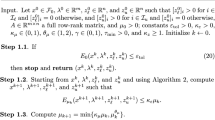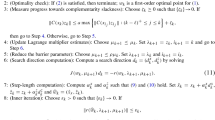Abstract
It was recently shown that modified barrier methods are not only theoretically but also computationally superior to classic barrier methods when applied to general nonlinear problems. In this paper, a penalty-barrier function is presented that was designed to overcome particular problems associated with modified log-barrier functions. A quadratic extrapolation of logarithmic terms as well as handling simple bounds separately are utilized. The resulting penalty-barrier method is outlined and compared to previous methods. The conclusion drawn from the computational tests is that the revised method exhibits superior performance on the test set of this study and consequently holds promise as a viable technique for general nonlinear programming.
Similar content being viewed by others
References
A. Ben-Tal, I. Yuzefovich and M. Zibulevsky, Penalty/barrier multiplier methods for minimax and constrained smooth convex problems, Research Report 9/92, Optimization Laboratory, Faculty of Industrial Engineering and Management, Technion, Haifa, Israel (1992).
I. Bongartz, A.R. Conn, N.I.M. Gould and P.L. Toint, CUTE: Constrained and Unconstrained Testing Environment, Technical Report 93/10, Department of Mathematics, Facultés Universitaires de Namur, Namur, Belgium (1993).
M.G. Breitfeld and D.F. Shanno, Preliminary computational experience with modified log-barrier functions for large-scale nonlinear programming, in:Large Scale Optimization: State of the Art ed. W.W. Hager, D.W. Hearn and P.M. Pardalos (Kluwer Academic, 1994), pp. 45–67.
A.R. Conn, N.I.M. Gould and P.L. Toint, A globally convergent Lagrangian, Technical Report 92/07, (Department of Mathematics, Facultés Universitaires de Namur, Namur, Belgium (1992).
R.S. Dembo, A set of geometric programming test problems and their solutions, Mathematical Programming 10(1976)192–213.
A.V. Fiacco and G.P. McCormick,Nonlinear Programming: Sequential Unconstrained Minimization Techniques (Wiley, New York, 1968); Reprint: Vol. 4 ofSIAM Classics in Applied Mathematics (SIAM Publ., Philadelphia, PA, 1990).
R. Fletcher,Practical Methods of Optimization, 2nd ed. (Wiley, New York, 1987).
C.A. Floudas and P.M. Pardalos,A Collection of Test Problems for Constrained Global Optimization Algorithms Lecture Notes in Computer Science 455 (Springer, Berlin, 1990).
K.R. Frisch, The logarithmic potential method for convex programming, unpublished manuscript, Institute of Economics, University of Oslo, Oslo, Norway (May 1955).
P.E. Gill and W. Murray, Newton-type methods for unconstrained and linearly constrained optimization, Mathematical Programming 7(1974)311–350.
P.E. Gill and W. Murray, Safeguarded steplength algorithms for optimization using descent methods, Report NAC, 37, National Physical Laboratory, Teddington, England (1974).
W. Hock and K. Schittkowski,Test Examples for Nonlinear Programming Codes, Lecture Notes in Economics and Mathematical Systems 187 (Springer, Berlin, 1981).
J.J. Moré and D.C. Sorensen, Newton's method, in:Studies in Numerical Analysis, ed. G.A. Golub (Mathematical Association of America, 1984) pp. 29–82.
W. Murray, Analytical expressions for eigenvalues and eigenvectors of the Hessian matrices of barrier and penalty functions, Journal of Optimization Theory and Applications 7(1971)181–196.
W. Murray and M.H. Wright, Line search procedures for the logarithmic barrier function, SIAM Journal on Optimization 4(1994)229–246.
S.G. Nash, R. Polyak and A. Sofer, A numerical comparison of barrier and modified-barrier methods for large-scale bound-constrained optimization, in:Large Scale Optimization: State of the Art, ed. W.W. Hager, D.W. Hearn and P.M. Pardalos (Kluwer Academic, 1994) pp. 319–338.
R. Polyak, Modified barrier functions (theory and methods), Mathematical Programming 54(1992)177–222.
D.F. Shanno and K.H. Phua, Numerical experience with sequential quadratci programming algorithms for equality constrained nonlinear programming, Transactions on Mathematical Software 15(1989)49–63.
J. Stoer and R. Bulirsch,Introduction to Numerical Analysis, 2nd ed., Texts in Applied Mathematics 12 (Springer, New York, 1993).
Author information
Authors and Affiliations
Rights and permissions
About this article
Cite this article
Breitfeld, M.G., Shanno, D.F. Computational experience with penalty-barrier methods for nonlinear programming. Ann Oper Res 62, 439–463 (1996). https://doi.org/10.1007/BF02206826
Issue Date:
DOI: https://doi.org/10.1007/BF02206826




